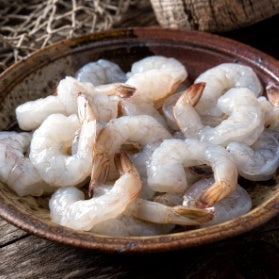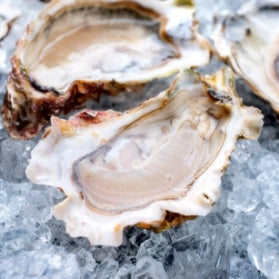Your Cart is Empty
FREE SHIPPING ON ALL ORDERS OVER $125!
FREE SHIPPING ON ALL ORDERS OVER $125!
FREE SHIPPING ON ALL ORDERS OVER $125!

When it comes to farm-raised salmon, there is a lot of misinformation out there.
Even though farm-raised salmon makes up an estimated 70% of the salmon consumed worldwide, many people still believe that it is “unhealthy” and less nutritious or of lower quality than wild fish.
If you’ve ever wondered “How bad is farm-raised salmon?” and want real answers, you’ve come to the right place. Our team here at North Coast Seafoods has been sourcing and supplying the highest quality, sustainable seafood since 1957. With over 70 years of experience, we are committed to sharing accurate, transparent knowledge about seafood.
At the end of the day, both wild-caught and farmed salmon can be high-quality, sustainable, and delicious choices. One is not inherently better than the other, and both are necessary to ensure continued seafood availability for future generations.
Read on to learn the truth about farm-raised salmon, which will empower you to make the most informed choices for your health and the environment.
Similar to farms that raise chicken, pork, and beef, there are also farms that cultivate seafood for consumption. Farmed seafood is also known as aquaculture, which by definition is simply the practice of raising seafood from juvenile through adult stage under carefully controlled conditions.
This whole process replicates the wild conditions salmon would naturally grow in and can be done directly in ocean waters. Aquaculture, and salmon farms, in particular, are one of the fastest-growing means of global food production.
Farmed Salmon is one of the best ways to keep up with the growing demand for seafood worldwide. The National Oceanic and Atmospheric Administration (NOAA) also emphasizes how important aquaculture is to restoring habitat and replenishing wild stocks, and rebuilding populations of threatened and endangered seafood species.
According to NOAA, the majority (80%) of aquaculture in the United States consists of bivalve mollusks such as oysters, clams, and mussels. However, salmon and shrimp make up the majority of the remaining percentage of farmed seafood.
Aquaculture in North America occurs mostly on the coast of the Atlantic, Pacific, and the Gulf of Mexico. Since fish like salmon thrive in cold waters, they are mostly farmed in Chile, Norway, Canada, and Scotland. However, farmed fish operations have also expanded to Australia, Iceland, Ireland, and New Zealand, among other places.
North Coast’s Norwegian Salmon are ocean-raised in the pristine fjords of Norway, which border the Arctic Circle.
Farmed salmon feed is typically made up of plant-based ingredients, fish-based ingredients (including fishmeal, fish oil, and fish protein), as well as vitamins, minerals, amino acids, and astaxanthin, an antioxidant. This antioxidant, which is consumed naturally by wild salmon, supports fish immune health and gives salmon its iconic “salmon” color.
Altogether, these ingredients closely replicate wild salmon’s omnivorous diet.
North Coast’s Norwegian Salmon are fed a premium diet made of plant-based ingredients and oily fish like anchovy, herring, and mackerel. Our farmed Norwegian salmon is also free of growth hormones, antibiotics, and chemicals.
Like with most protein sources, what salmon eat can significantly affect their flavor and texture. In other words, the principle “You are what you eat” applies to salmon in the same way it applies to humans!
Wild salmon are typically leaner because they are highly migratory, often swimming upstream against strong currents, which burns calories and reduces their fat content. Their diet is also typically lower in fat, which results in a milder, sometimes “fishier”, flavor profile.
In contrast, farmed salmon usually are fed a customized diet that is richer in oil and fat (the good kind!). This high-fat diet is what gives farmed salmon higher levels of omega-3 fatty acids and a “melt in your mouth” texture often preferred by chefs.

Of course, not all farm-raised salmon are equal. The primary reason why so many people believe that farm-raised salmon is bad comes from the stereotype that farmed salmon are raised in dirty ponds, squished into tiny cages, and treated inhumanely.
In the vast majority of modern operations, this simply isn’t the case. The practice of farming salmon has existed for over 40 years and there have been substantial advances in technology that allow for
It is important to remember that just like with agriculture (farm-raised chicken, beef, and pork), there are good farms and bad farms. That is why it is important to buy from a trusted grocery store and whenever possible, look for certified sustainable salmon that is certified by independent third parties like the Aquaculture Stewardship Council (ASC) or the Best Aquaculture Practices (BAP).
These organizations set strict requirements for responsible seafood farming that protect the ocean’s ecosystems and water quality, enforce rigorous criteria for sustainable feed, limit antibiotic use, and manage fish health and welfare.
Looking for these sustainability certifications can give you additional peace of mind that when you eat certified sustainable farmed salmon, you are enjoying the high-quality seafood that’s good for you, the ocean, and the environment.
We hope that by now you are beginning to realize that farmed salmon is not inherentlybad, unhealthy, or irresponsible. Both wild-caught and farmed seafood can be great choices when they’re raised with care in a responsible manner. Here are some more benefits of farm-raised salmon to keep in mind.
Salmon is extremely healthy to eat and contributes to a variety of health benefits. Both farmed and wild salmon are excellent sources of Omega-3 fatty acids and a rich source of Vitamin D. Omega 3s have been shown to reduce inflammation, lower blood cholesterol levels, and help decrease the risk of cardiovascular disease.
Farmed and wild salmon have very similar nutrition profiles so there is truly not a “better” option – both are great for you and, when raised or caught responsibly, for the planet too.

Overfishing is a major problem around the world. There is a reason there is no more cod left on Cape Cod. And according to the World Wildlife Foundation, overfishing is one of the most significant drivers of declines in ocean wildlife populations.
When people catch more fish than can be replenished, it can wreak havoc on entire ecosystems and negatively impact food chains as a result. With seafood consumption rising worldwide, well-managed farmed fish can take pressure off wild fisheries, where 80% of wild fish stocks are harvested at full capacity.
In this way, when caught and raised responsibly, wild salmon and farmed salmon work together to maintain a healthy ecosystem and ensure continued seafood availability for generations to come.
As we’ve discussed on our sustainability blog, research has shown that farmed salmon has a significantly lower carbon footprint than any other center-of-the-plate protein source. Just consider how much land and freshwater is required to farm chicken, beef, and pork.
In contrast, farm-raised salmon requires no land or additional water resources to harvest and even has a lower impact on wildlife compared to land-based proteins.
At North Coast Seafoods, we proudly offer both farm-raised Norwegian Salmon and wild Alaska Salmon that contain NO Chemicals, NO Antibiotics, NO Preservatives, and NO Additives. Enjoy only the best seafood delivered directly to your door from North Coast Seafoods.
September 13, 2024
This is an excellent article and should put to rest the many concerns people have about farmed salmon. Thank you for being so thorough and making it easy to understand.
Comments will be approved before showing up.



Sign up to receive the best seafood recipes, first access to new products, exclusive discounts and more!
Peg Doyle
September 13, 2024
I forgot to mention I plan to post your article on my FB page and create a link in my next Wellness and you newsletter.